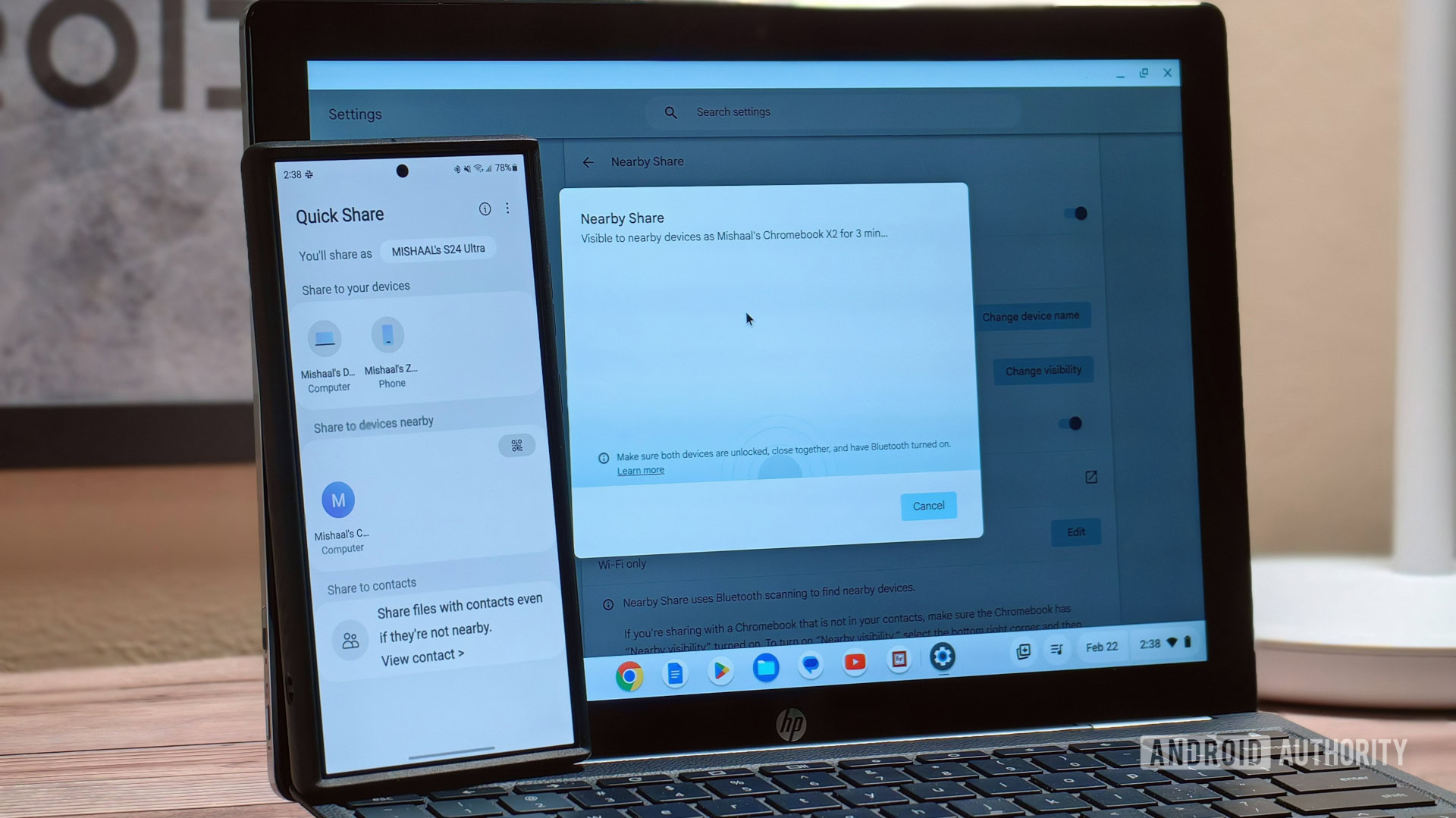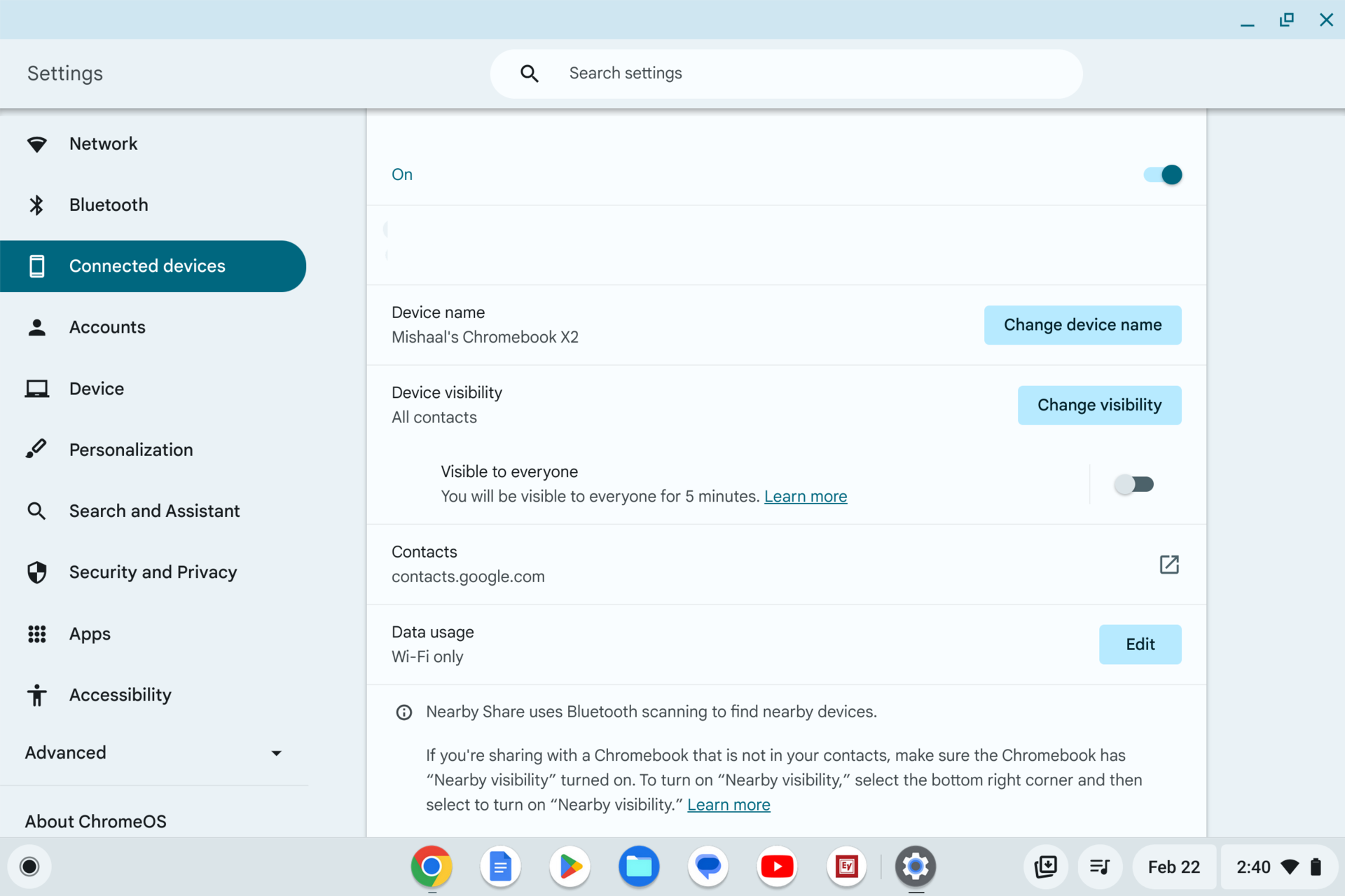Affiliate links on Android Authority may earn us a commission. Learn more.
Quick Share on Chrome OS might finally be as fast as it is on phones

- Chrome OS currently does not support peer-to-peer Wi-Fi, but it looks like that will change soon.
- This will allow Quick Share (formerly Nearby Share) to work faster than it currently does on Chrome OS.
- Android devices already support peer-to-peer Wi-Fi.
Google’s Chrome OS operating system has many neat features that help integrate your Android phone with your Chromebook. Most of these cross-device features are under the Phone Hub umbrella, but there’s an additional feature that you’re probably already familiar with if you frequently share files between Android devices: Quick Share.
Quick Share (formerly Nearby Share) lets you share files between Android devices, Chromebooks, and Windows PCs. Just like on Android, the feature is baked into the operating system on Chromebooks. Unlike most Android devices, though, Chromebooks lack a key connectivity feature that enables the fastest transfer speeds for sharing files through Quick Share, but that’s set to change soon.
What is Wi-Fi Direct?

Quick Share supports transferring files via Bluetooth or Wi-Fi. Bluetooth is used to scan for nearby devices and then connect them, but it’s typically not used for actually transferring files. That’s because it’s significantly slower than Wi-Fi when it comes to transmitting data, making it the last resort when a suitable Wi-Fi connection can’t be established.
Establishing a Wi-Fi connection is pretty straightforward on Android, Chrome OS, and Windows, as you just need to have the sender and receiver devices connected to the same Wi-Fi network. However, if you’re sharing files between two or more Android devices, you don’t even need to connect them to the same Wi-Fi access point to get the fastest transfer speeds. That’s because Quick Share on Android can utilize Wi-Fi Direct, ie. peer-to-peer Wi-Fi.
Wi-Fi Direct allows for a peer-to-peer Wi-Fi experience, facilitating very fast transfer speeds.
Wi-Fi Direct is a standard that allows Wi-Fi enabled devices to directly connect to each other without the need for an intermediary router or access point. One device (the sender) creates a temporary Wi-Fi hotspot that other devices (the receivers) can connect to. Unlike the Wi-Fi hotspot feature built into most Android phones, you don’t need to fiddle with network settings to create or join a Wi-Fi Direct network when you’re just trying to share some files between Android devices. That’s because Quick Share utilizes Android’s Wi-Fi Direct APIs to create a network on the sender device, to which the receiver devices then automatically connect.
Thanks to Wi-Fi Direct, Android devices don’t need to be connected to the same access point to get the best file transfer speeds since Quick Share can just turn the sender device into a portable Wi-Fi hotspot, no matter the location. Data transfers over a Wi-Fi Direct connection can theoretically be faster than over a traditional Wi-Fi connection since there won’t be any overhead from a router or other devices on the same network competing for bandwidth. Other factors like distance to the access point and the router’s Wi-Fi chip’s specs could impact transfer speeds, too. Plus, it isn’t always easy (or cheap) to get every device onto the same wireless network, especially when you’re traveling.
Wi-Fi direct is coming to Chrome OS
It’s clear that a peer-to-peer Wi-Fi connection is the best medium for sharing files via Quick Share, but sadly, Chrome OS doesn’t support Wi-Fi Direct. That’s set to change in the future, though, as the Chrome OS team has been working on implementing support for peer-to-peer Wi-Fi over the last few months. Numerous code changes under the “p2p” topic have been merged to the Chromium Gerrit, and just a few days back, a code change that added a feature flag to enable Wi-Fi Direct on Chrome OS was merged.
The description of this feature flag reads as follows: Enables the WiFi direct functionalities in ChromeOS. Although the flag’s description doesn’t directly name Quick Share, the patch’s description says the flag’s purpose is to “enable or disable Wi-Fi direct medium for Nearby Share.” Furthermore, a comment in one of the patched files says that this flag, when enabled, “will allow the Nearby Share feature to utilize Wi-Fi P2P for sharing data.” The reason that Nearby Share was removed from the flag’s description is that Wi-Fi Direct can be used by other applications like WiDi Streaming Cast (i.e., wireless display streaming).
We don’t know when Wi-Fi Direct support will roll out to existing Chromebooks, but the flag should be showing up in preview tracks of Chrome OS soon. As for when Quick Share on Chrome OS will be updated to utilize Wi-Fi Direct, that’s another thing we aren’t sure of. It’s likely that many existing Chromebooks will support this feature once it rolls out, though, given how old the peer-to-peer Wi-Fi standard is compared to the Wi-Fi chips in modern devices. Hopefully, Google shows some of this love to their Windows client for Quick Share, which similarly lacks Wi-Fi Direct support despite the fact that Microsoft seems to offer APIs for it.